My first flickr picture.
Yikes.
I can't quite grasp it yet, but this appears to be an astonishing increase in personal capability: I can post, share, store, organize and tag anything I have in my stock photo files, and I can determine the level of sharing I wish to do with the asset. I can even sell it. The cooler part is this: I can acquire anything anyone else has shared.
This is apparently an example of what some call "web 2.0".
It is manifestly about collaboration, and to some extent, it is about trust.
Tuesday, November 29, 2005
Monday, November 28, 2005
Long-tail economics
The tech bloggers are warning us that what's coming is a set of new web apps and services that have "long-tail economics" at the heart of their business models. Wired magazine recently described the long tail phenomenon. Essentially, it's a lot of small publishers getting relatively few hits as opposed to a few biggies dominating the publishing space. "(This is ) an entirely new economic model for the media and entertainment industries, one that is just beginning to show its power. Unlimited selection is revealing truths about what consumers want and how they want to get it in service after service, from DVDs at Netflix to music videos on Yahoo! Launch to songs in the iTunes Music Store and Rhapsody. People are going deep into the catalog, down the long, long list of available titles, far past what's available at Blockbuster Video, Tower Records, and Barnes & Noble."
So much for the mainstream. More and more, we will find it easy to drill down to that particular content that interests us--whether it be music, videos, books, or simply the thoughts and writings of other people anywhere on the planet.
So much for the mainstream. More and more, we will find it easy to drill down to that particular content that interests us--whether it be music, videos, books, or simply the thoughts and writings of other people anywhere on the planet.
Monday, November 21, 2005
More on the Flat World
For corporate media managers to ask themselves:
Are we learning to use the new tools of collaboration?
(Friedman lists them, where are we at on the tools that have shaped the flat world: shared data, workflow, blogs, wikis, supply chain mangement, wireless and remote)
Do we fully appreciate outsourcing?
(Have we made outsourcing a bugaboo?...are we so busy resisting it that we are missing the opportunity to do a better job, to evolve our jobs? Conversely, should we be in-sourcing to capitalize on our strengths and assets?)
Are we properly specialized? (related to the above, involves digging into our selves, x-raying ourselves personally, departmentally, and corprately to see who we are and what we do)
Are we building trust?
(Say what you will about technology and efficiency, business is done in a social context. Trust is a keystone of economic behavior; how do we build it here, how remotely?)
Do we run through Kubler-Ross' 5 stages of grief: denial, anger, bargaining, depression and acceptance?
Are we learning to use the new tools of collaboration?
(Friedman lists them, where are we at on the tools that have shaped the flat world: shared data, workflow, blogs, wikis, supply chain mangement, wireless and remote)
Do we fully appreciate outsourcing?
(Have we made outsourcing a bugaboo?...are we so busy resisting it that we are missing the opportunity to do a better job, to evolve our jobs? Conversely, should we be in-sourcing to capitalize on our strengths and assets?)
Are we properly specialized? (related to the above, involves digging into our selves, x-raying ourselves personally, departmentally, and corprately to see who we are and what we do)
Are we building trust?
(Say what you will about technology and efficiency, business is done in a social context. Trust is a keystone of economic behavior; how do we build it here, how remotely?)
Do we run through Kubler-Ross' 5 stages of grief: denial, anger, bargaining, depression and acceptance?
Tuesday, November 15, 2005
A Media Map
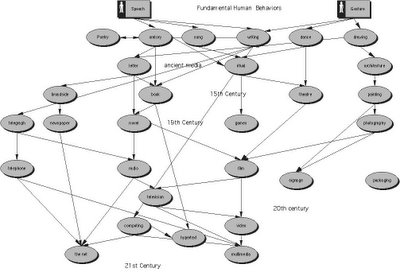
This is a project that could take a lot of time: mapping the various media forms as they have evolved over the ages, from ancient Greek drama and poetry to online computer games. It could also call for a real scholar, which I am not.
Why? Because we who work in the media professionally must continually reevaluate our media choices as the clutter of mediated content continues to grow. Attention is the ultimate bandwidth issue; our ability to get and hold the user's attention will require us to exploit all the art forms humans have ever created to exhort, delight, entertain, and educate.
In the wholly unreadable chart above, I've speculated that all forms of communication art emerge from two fundamental human behaviors: speech and gesture. The arrows suggest the evolution of the forms from the classic seven arts of the Greeks forward. Scott McCloud's books on the art of comics gave me a lot of good ideas. This is just a start. A really complete map would be scalable (like Google Earth) and have hyperlinks to articles and more links to books and examples of the forms themselves.
CMMA Short Bit
Fall CMMA Short Bit presentation:
As we focus on our creative inspirations during this conference, let me share some of mine, at least from the province of books.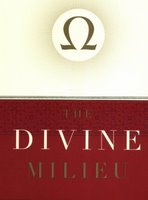
I’m not going to talk about fiction. That’s a whole thing in itself. For me, there have been a handful of non-fiction books that I have come back to again and again in my adult life and have deeply influenced my work as a media professional. I can’t share a lifetime of reading in 5 to seven minutes, so I’ll quickly mention just five books.
One I read when I was 19, and a very serious young man. The book was The Divine Milieu by French Jesuit Philosopher and evolutionist Theilhard Chardin. He had a vision, very impractical, very “out there” --not be realized for a thousand years, that human consciousness had evolved out of the minerals of the universe, arising in life forms and flowering in the human as a spiritual sense. He believed it was Man’s destiny to merge eventually into a collective cosmic awareness he called the “noosphere”.
This book was a milestone for me -- my first encounter with a really big idea, and it was so exciting. Even though I’ve wandered away from this kind of religious speculation, a fascination and hunger to find the big ideas hiding in the mundane has stayed with me ever since.
If only Pierre Chardin could have lived fifty more years to see the world wide web, to see a billion people able to connect at the speed of light and catch the movie trailer for Wedding Crashers in Chinese! But seriously, the web does present major implications for the human family, even if all the things it promises may not come without pain.
One of those books I’ve just finished reading is The World is Flat, by L Thomas Friedman.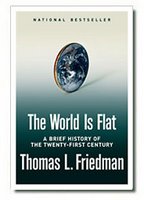 We’ve heard our keynote speaker allude to it, and I know a few of you here have read it too. Friedman modestly subtitles it “a brief history of the 21st century”. Friedman, like Chardin, chases a globalization theme. He gives us a pretty darned gripping account of the technological and economic revolution that has been going on while most of us were distracted with 9/11 and what followed.
We’ve heard our keynote speaker allude to it, and I know a few of you here have read it too. Friedman modestly subtitles it “a brief history of the 21st century”. Friedman, like Chardin, chases a globalization theme. He gives us a pretty darned gripping account of the technological and economic revolution that has been going on while most of us were distracted with 9/11 and what followed.
He’s telling the story that is affecting every one of us in this room! I have been assaulting everyone I know telling them they MUST read this book and was delighted to see it pop up right here at CMMA--- written into the theme of our next CMMA Spring Professional Development Conference that Bill Marriot and others will be hosting in North Carolina next year.
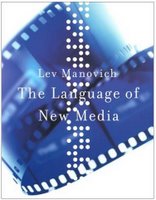 Another big book for me was The Language of the New Media by Lev Manovich. This is not an easy book, but it is a very rich one. I keep going back to it and finding insights into what we try to do with things like websites and multimedia. Manovich teaches media theory at UCLA. One of his big bombs is that the new interactive media we see playing out on the web are more than HTML versions of books or cinema. The new media are databases, and users are not passive audiences but active users. We will keep their attention only if we understand and use the new rules --building database worlds for users to explore.
Another big book for me was The Language of the New Media by Lev Manovich. This is not an easy book, but it is a very rich one. I keep going back to it and finding insights into what we try to do with things like websites and multimedia. Manovich teaches media theory at UCLA. One of his big bombs is that the new interactive media we see playing out on the web are more than HTML versions of books or cinema. The new media are databases, and users are not passive audiences but active users. We will keep their attention only if we understand and use the new rules --building database worlds for users to explore.
I’m still learning from this guy.
I am an armchair architect. One of those books that’s affected my life and my work is Pattern Language by Christopher Alexander, and others.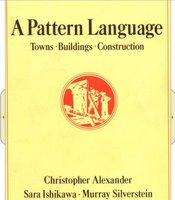
My copy is well-thumbed.
A Pattern Language lays out the elements of building, prescribing general rules of how things work best, from the perfect positioning of a reading chair next to a sunny window, to the principle determining how high counters should be in a workplace.
Christopher says he found these classic patterns hidden in the vernacular; the past two thousand years of human building. He lays out about 300 of these patterns. He shows how they can be used by anyone—not just professional architects and builders—to make a fit and beautiful habitation.
Alexander’s big idea about patterns has popped up the art of writing computer code—and the open source movement—the guys who brought us Linux and APACHE server and PERL and free Blogger! Its all about discovering and applying those most “fitting and beautiful” patterns. It occurred to me some years ago that another pattern language might exist for media forms just as well as buildings did in Alexander’s classic book.
A big project to do someday, perhaps.
I have come to think that there are patterns hidden in media for us to figure out and use to make fitting and beautiful media things. Right now I’m really on fire about the pattern language hidden in Podcasting. Last summer I started looking at audio blogs and their subscription-based cousins, Podcasts, for work. The idea is produce short "radio" pieces with corporate training content and make them available for download, or subscription via RSS.
This my current passion! My fire has been lit for the year!! I’m all on fire about the new medium of the 21st century! Radio! I am going to get my clients excited because production costs will be significantly lower than what we spend on even a very modest video project.
Radio breaks out of the box called “screentime”, and once the user subscribes to a show, new installments are downloaded automatically and saved on their hard drives. It’s time-shifted radio. You listen when and where you want.

One last book to mention. I’m slaking my hunger for big ideas about media right now by following up my reading of Understanding Comics by Scout McCloud with his Reinventing Comics. He shows us that comics is a serious medium, worthy of our study, not just as it relates to print, but online too. Big ideas here---lots of implications for our kind of work.
I’m out of time, but I’ll post this little list and my comments on my weblog if you are interested. As you see me walking around please feel free to ask me about my podcast pilot, or pattern languages or Chardin, if you really have time to kill! Thanks.
As we focus on our creative inspirations during this conference, let me share some of mine, at least from the province of books.

I’m not going to talk about fiction. That’s a whole thing in itself. For me, there have been a handful of non-fiction books that I have come back to again and again in my adult life and have deeply influenced my work as a media professional. I can’t share a lifetime of reading in 5 to seven minutes, so I’ll quickly mention just five books.
One I read when I was 19, and a very serious young man. The book was The Divine Milieu by French Jesuit Philosopher and evolutionist Theilhard Chardin. He had a vision, very impractical, very “out there” --not be realized for a thousand years, that human consciousness had evolved out of the minerals of the universe, arising in life forms and flowering in the human as a spiritual sense. He believed it was Man’s destiny to merge eventually into a collective cosmic awareness he called the “noosphere”.
This book was a milestone for me -- my first encounter with a really big idea, and it was so exciting. Even though I’ve wandered away from this kind of religious speculation, a fascination and hunger to find the big ideas hiding in the mundane has stayed with me ever since.
If only Pierre Chardin could have lived fifty more years to see the world wide web, to see a billion people able to connect at the speed of light and catch the movie trailer for Wedding Crashers in Chinese! But seriously, the web does present major implications for the human family, even if all the things it promises may not come without pain.
One of those books I’ve just finished reading is The World is Flat, by L Thomas Friedman.
 We’ve heard our keynote speaker allude to it, and I know a few of you here have read it too. Friedman modestly subtitles it “a brief history of the 21st century”. Friedman, like Chardin, chases a globalization theme. He gives us a pretty darned gripping account of the technological and economic revolution that has been going on while most of us were distracted with 9/11 and what followed.
We’ve heard our keynote speaker allude to it, and I know a few of you here have read it too. Friedman modestly subtitles it “a brief history of the 21st century”. Friedman, like Chardin, chases a globalization theme. He gives us a pretty darned gripping account of the technological and economic revolution that has been going on while most of us were distracted with 9/11 and what followed.He’s telling the story that is affecting every one of us in this room! I have been assaulting everyone I know telling them they MUST read this book and was delighted to see it pop up right here at CMMA--- written into the theme of our next CMMA Spring Professional Development Conference that Bill Marriot and others will be hosting in North Carolina next year.
 Another big book for me was The Language of the New Media by Lev Manovich. This is not an easy book, but it is a very rich one. I keep going back to it and finding insights into what we try to do with things like websites and multimedia. Manovich teaches media theory at UCLA. One of his big bombs is that the new interactive media we see playing out on the web are more than HTML versions of books or cinema. The new media are databases, and users are not passive audiences but active users. We will keep their attention only if we understand and use the new rules --building database worlds for users to explore.
Another big book for me was The Language of the New Media by Lev Manovich. This is not an easy book, but it is a very rich one. I keep going back to it and finding insights into what we try to do with things like websites and multimedia. Manovich teaches media theory at UCLA. One of his big bombs is that the new interactive media we see playing out on the web are more than HTML versions of books or cinema. The new media are databases, and users are not passive audiences but active users. We will keep their attention only if we understand and use the new rules --building database worlds for users to explore.I’m still learning from this guy.
I am an armchair architect. One of those books that’s affected my life and my work is Pattern Language by Christopher Alexander, and others.

My copy is well-thumbed.
A Pattern Language lays out the elements of building, prescribing general rules of how things work best, from the perfect positioning of a reading chair next to a sunny window, to the principle determining how high counters should be in a workplace.
Christopher says he found these classic patterns hidden in the vernacular; the past two thousand years of human building. He lays out about 300 of these patterns. He shows how they can be used by anyone—not just professional architects and builders—to make a fit and beautiful habitation.
Alexander’s big idea about patterns has popped up the art of writing computer code—and the open source movement—the guys who brought us Linux and APACHE server and PERL and free Blogger! Its all about discovering and applying those most “fitting and beautiful” patterns. It occurred to me some years ago that another pattern language might exist for media forms just as well as buildings did in Alexander’s classic book.
A big project to do someday, perhaps.
I have come to think that there are patterns hidden in media for us to figure out and use to make fitting and beautiful media things. Right now I’m really on fire about the pattern language hidden in Podcasting. Last summer I started looking at audio blogs and their subscription-based cousins, Podcasts, for work. The idea is produce short "radio" pieces with corporate training content and make them available for download, or subscription via RSS.
This my current passion! My fire has been lit for the year!! I’m all on fire about the new medium of the 21st century! Radio! I am going to get my clients excited because production costs will be significantly lower than what we spend on even a very modest video project.
Radio breaks out of the box called “screentime”, and once the user subscribes to a show, new installments are downloaded automatically and saved on their hard drives. It’s time-shifted radio. You listen when and where you want.

One last book to mention. I’m slaking my hunger for big ideas about media right now by following up my reading of Understanding Comics by Scout McCloud with his Reinventing Comics. He shows us that comics is a serious medium, worthy of our study, not just as it relates to print, but online too. Big ideas here---lots of implications for our kind of work.
I’m out of time, but I’ll post this little list and my comments on my weblog if you are interested. As you see me walking around please feel free to ask me about my podcast pilot, or pattern languages or Chardin, if you really have time to kill! Thanks.
Subscribe to:
Posts (Atom)
